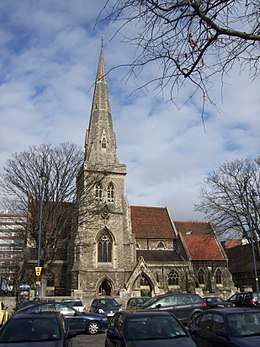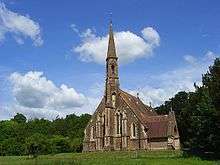John Johnson (architect, born 1807)
John Johnson (1807 – 28 December 1878) was an English architect who specialised in religious buildings and churches in the Gothic style. He was regularly employed by the civil engineer Sir John Kelk to design the homes and public buildings he funded. Johnson is best known for his collaboration with Alfred Meeson on designs for Alexandra Palace in north London; his designs for the Church of St Edward the Confessor in Romford, Essex; and for the Grade I listed St Mary's Church in Tidworth, Wiltshire, which was completed the year he died.
.jpg)
As a result of the land on which one of Johnson's churches – St Luke's Church, Euston Road – was sitting being purchased by the Midland Railway, the building was dismantled, moved to Wanstead in north-east London, and re-erected as a Congregational church. Johnson's participation in the work gave him the distinction of becoming one of a small number of architects to have undertaken such a move and subsequent reconstruction.
Personal life
John Johnson was born in 1807; little is known of his life, but he enjoyed fishing, and was for ten years on the committee of the Thames Angling Preservation Society.[1]
On 11 March 1846 Johnson announced in the Bury and Norwich Post that he was establishing his private practice at 11 Whiting Street, Bury St Edmunds, Suffolk.[2] He remained there throughout the 1850s,[3] and appears to have relocated to London in the following decade where he became the district surveyor for the London Borough of East Hackney;[1] in the capital, he practised and resided at 14 Buckingham Street, Strand.[4]
On 1 July 1865, Johnson's only child, John George, a second assistant engineer aboard HMS Weazel, died aged 28 through drowning whilst the boat was docked in Shanghai.[5]
Career
Churches

Johnson was a prolific designer of religious buildings and churches. In 1849 he was instructed to design the Church of St Edward the Confessor in Romford, Essex,[6] and returned in 1864 to complete his second church in the town, St Andrew's, in what is in now the Waterloo Estate.[7] In 1853 he took on the rebuilding of the parish church of All Saints in Beyton, Suffolk, which retained the medieval core and tower.[8]
Johnson created the original designs for St Luke's Church, Euston Road, between 1856 and 1861. In 1866 it was dismantled and re-designed by Johnson, and re-erected as a Congregational church in Wanstead. The church was relocated because of the purchase of land by the Midland Railway, which obtained an Act of Parliament in 1863 to extend its line to London and build a new terminus, (which became St Pancras railway station) on the land occupied by Johnson's church. It was described by Historic England as "one of few examples of churches which have been moved and substantially reconstructed to their original form, and by the original architect".[9]
Other religious buildings followed, including the Old Vicarage in Oakley Square, Camden, in 1861;[10] and St Andrews Church in Hertford in 1875.[11][12] One of his final churches was St Mary's Church in Tidworth, Wiltshire, which was completed in the year in which Johnson died. It is his only Grade I listed building.[13][14]
Public and private buildings
Johnson was closely associated with the civil engineer Sir John Kelk (1816–1886) who instructed Johnson to complete the Army and Navy Club in St James's Square, London; Kelk's personal residence at 3 Grosvenor Square, London;[1] and St Mary's Church, which was built on Kelk's estate in Tidworth, Wiltshire.[13]
Kelk and Johnson worked together in 1862 as part of the Kensington Exhibition,[1] and again on the construction of Alexandra Palace, which Johnson co-designed with Alfred Meeson (1808–1885). The palace burnt down in 1873 and Johnson and Meeson designed the new building which exists to this day.[15] Kelk personally funded the project and used the contractors Charles and Thomas Lucas to construct the property.[1]
Death and legacy
Johnson died at the age of 71 on 28 December 1878 at his home, 14 Buckingham Street, near the Strand, London.[16] Probate was granted to his executors, Lewis Edward Younghusband of 91 Highbury New Park, Middlesex, the sculptor Edward Bowring Stephens of 110 Buckingham Palace Road, Middlesex, and Alfred Godwin of 3 King's Bench Walk, Temple.[17]
Johnson's designs for the Town Hall in Staines, Surrey, were submitted as part of a public competition in 1878; the building was completed between 1879 and 1880.[18]
References
- John Johnson (1807–1878). Archived 2018-01-27 at the Wayback Machine Jacqueline Banerjee, The Victorian Web, 8 December 2015. Retrieved 27 January 2018.
- "John Johnson: Architect and Surveyor", Bury and Norwich Post, 11 March 1846, p. 2.
- "To Builders: Bildeston New School", 20 April 1853, p. 2.
- "To Builders", Windsor and Eaton Express, 18 January 1868, p. 1.
- "Deaths", The Bury and Norwich Post and Suffolk Herald, 26 September 1865, p.5.
- Historic England. "St Edward the Confessor's Church (Market Place) (1358535)". National Heritage List for England. Retrieved 27 January 2018.
- Historic England. "Church of St Andrew (1184660)". National Heritage List for England. Retrieved 26 January 2018.
- Historic England. "Church of All Saints (1032500)". National Heritage List for England. Retrieved 27 January 2018.
- Historic England. "Wanstead United Reformed Church (1393337)". National Heritage List for England. Retrieved 27 January 2018.
- Historic England. "The Old Vicarage and attached railings, gate & wall (1322083)". National Heritage List for England. Retrieved 27 January 2018.
- Historic England. "Church of St Andrew, Hertford (1268748)". National Heritage List for England. Retrieved 26 January 2018.
- "Hertford St Andrews: Interesting features of the present building". www.hertfordstandrews.co.uk. Archived from the original on 27 January 2018.
- Historic England. "Church of St Mary (1093240)". National Heritage List for England. Retrieved 27 January 2018.
- "St Mary's, South Tidworth". Victorian Web. Archived from the original on 17 March 2017. Retrieved 22 January 2018.
- Historic England. "Alexandra Palace including former Alexandra Palace Station to North (1268256)". National Heritage List for England. Retrieved 22 January 2018.
- "Deaths", The Standard, 31 December 1878, p. 1.
- 1879 Probate Calendar, p. 129.
- Historic England. "Staines Town Hall (1187053)". National Heritage List for England. Retrieved 27 January 2018.
Further reading
- Obituary in The Builder, 11 January 1879, pp. 53 & 137.
- Obituary in The Fishing Gazette, 3 January 1879, p. 7.
External links
| Wikimedia Commons has media related to John Johnson. |
